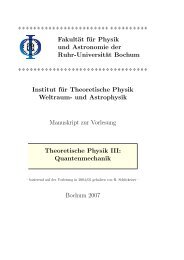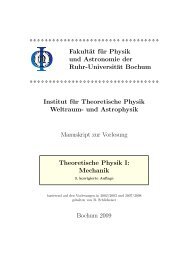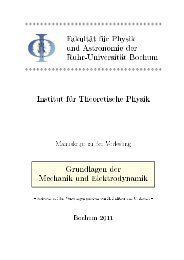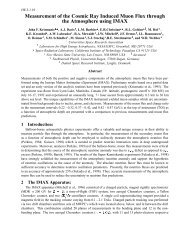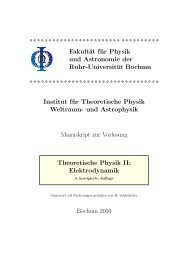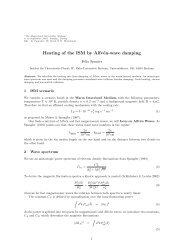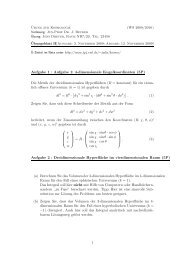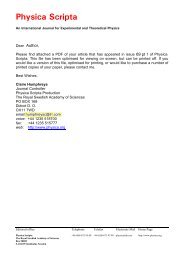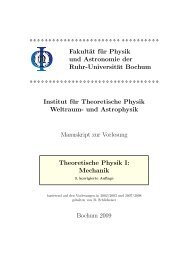pdf here - Theoretische Physik IV - Ruhr-Universität Bochum
pdf here - Theoretische Physik IV - Ruhr-Universität Bochum
pdf here - Theoretische Physik IV - Ruhr-Universität Bochum
You also want an ePaper? Increase the reach of your titles
YUMPU automatically turns print PDFs into web optimized ePapers that Google loves.
[19] bear electron temperatures of 10 9 K and ion temperatures 3 300 times hotter than that<br />
of the electrons. Our purpose in this paper is to investigate the behavior of the electrostatic<br />
waves in the inner region of the accretion disk by adopting an appropriate model. We<br />
consider a three-component e-p-i plasma in which the electrons and positrons are modeled<br />
by hydrodynamic (plasma-‡uid) equations and the ions are assumed to follow a Boltzmann<br />
distribution. We shall examine the e¤ects of the electron-to-ion temperature ratio, the<br />
positron-to-electron density ratio and the soliton propagation speed on the properties of<br />
nonlinear electrostatic excitations (solitons and double layers).<br />
In Section II, we present the governing equations for the electrostatic waves in our e-p-i<br />
plasma. In Sec. III, the reductive perturbation method is employed to derive a cylindrical<br />
Kadomtsev-Petviashvili equation (CKP). In Sec. <strong>IV</strong>, we obtain an appropriate equation<br />
which describes the evolution of the nonlinear ion-acoustic waves, including higher-order<br />
nonlinearity. The possibility of propagating electrostatic solitons and double layers is discussed<br />
in Sec. V. Finally, our results are summarized in Sec. VI.<br />
II.<br />
BASIC EQUATIONS<br />
We consider a collisionless, unmagnetized three-component plasma consisting of the electrons,<br />
positrons and singly charged positive ions. The nonlinear propagation of electrostatic<br />
waves in a two dimensional (2D) cylindrical geometry is governed by the electron/positron<br />
(denoted by the index e/p, respectively) continuity equation(s)<br />
@n e;p<br />
@t<br />
+ 1 r<br />
@<br />
@r (rn e;pu e;p ) + 1 @<br />
r @ (n e;pv e;p ) = 0; (1)<br />
and the e/p momentum equation(s),<br />
@u e;p<br />
@t<br />
+ u e;p<br />
@u e;p<br />
@r<br />
+ v e;p<br />
r<br />
@u e;p<br />
@<br />
v 2 e;p<br />
r<br />
+ 2 @n e;p<br />
e;p<br />
@r<br />
+ q @'<br />
e;p<br />
@r<br />
= 0; (2)<br />
and<br />
@v e;p<br />
@t<br />
+ u e;p<br />
@v e;p<br />
@r<br />
+ v e;p<br />
r<br />
@v e;p<br />
@<br />
+ u e;pv e;p<br />
r<br />
+ 2 e;p<br />
r<br />
@n e;p<br />
@r<br />
+ q e;p<br />
r<br />
@'<br />
@ = 0 : (3)<br />
Equations (1)-(3) are closed with the help of the Poisson equation,<br />
<br />
1 @<br />
r @' <br />
+ 1 @ 2 '<br />
r @r @r r 2 @ + X q 2 e;p n e;p + n i = 0: (4)<br />
e;p<br />
4



